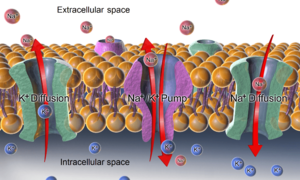Resting potential facts for kids
The resting potential is like the "quiet" electrical state of a cell. Imagine a tiny battery inside every living cell! When a cell isn't actively sending signals, it has a small electrical difference, or "voltage," across its outer skin (called the cell membrane). This voltage is the resting potential.
For most cells, the inside of the cell is slightly negative compared to the outside. This happens because of tiny charged particles called ions. These ions, like sodium and potassium, are found in different amounts inside and outside the cell. Special proteins in the cell membrane act like tiny pumps and gates, controlling where these ions go. This careful balance of ions and proteins helps create and maintain the resting potential. It's super important for how our nerves and muscles work!
Contents
What is Resting Potential?
Every living cell has a thin outer layer called the cell membrane. This membrane separates the inside of the cell from its surroundings. Think of it like a fence around a yard. Inside and outside this fence, there are different amounts of tiny charged particles called ions.
Why Cells Have a Resting Potential
The resting potential is the electrical difference across this membrane when the cell is not active. It's like a small electrical charge waiting to be used. This charge is usually negative inside the cell. This means there are more negative charges inside than outside.
How Ions Create the Charge
The main reason for this charge comes from different amounts of ions. Key ions involved are:
- Potassium ions (K+): There are usually more potassium ions inside the cell.
- Sodium ions (Na+): There are usually more sodium ions outside the cell.
- Chloride ions (Cl-): These are mostly outside the cell.
- Large proteins: Many large proteins inside the cell have a negative charge.
These ions move in and out of the cell through special protein channels in the membrane.
The Role of Ion Pumps
To keep the right balance of ions, cells use special "pumps." The most famous one is the sodium-potassium pump. This pump works hard to:
- Pump three sodium ions (Na+) out of the cell.
- Pump two potassium ions (K+) into the cell.
This pumping action uses energy and helps keep more sodium outside and more potassium inside. Because more positive charges (Na+) are pumped out than positive charges (K+) are pumped in, the inside of the cell becomes more negative.
Leaky Channels and Diffusion
Besides the pumps, there are also "leaky" channels in the membrane. These channels allow some ions to slowly leak across the membrane. Potassium ions, for example, can leak out of the cell more easily than sodium ions can leak in. This also helps make the inside of the cell more negative.
The movement of ions from an area of high concentration to an area of low concentration is called Diffusion. Ions also move because of electrical attraction or repulsion. The balance between these two forces (concentration and electrical charge) helps set the resting potential.
Why Resting Potential Matters
The resting potential is super important for many body functions, especially for nerve and muscle cells.
Nerve Cell Signals
Nerve cells (neurons) use changes in their membrane potential to send messages. The resting potential is their "starting point." When a nerve cell gets a signal, its membrane potential can quickly change, creating an "action potential." This is like a quick electrical pulse that travels along the nerve, allowing us to think, move, and feel.
Muscle Cell Contraction
Muscle cells also rely on resting potential. When a muscle cell receives a signal from a nerve, its resting potential changes. This change triggers the muscle to contract, allowing us to move our bodies.
In short, the resting potential is the stable electrical state of a cell when it's not active. It's created by the careful balance of ions and special protein pumps and channels in the cell membrane. This electrical difference is vital for how our nerves send signals and how our muscles move.
Images for kids
-
This diagram shows how a cell's electrical charge (membrane potential) develops because of potassium ions. Green arrows show potassium moving out, and red arrows show potassium moving back in due to the electrical charge. Only a tiny amount of potassium needs to move to create this important electrical difference.
See also
 In Spanish: Potencial de reposo para niños
In Spanish: Potencial de reposo para niños


